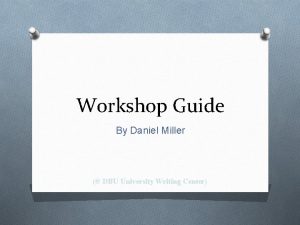Wheelchair Fatigue Reducer Aaron J Miller D Andre

- Slides: 1

Wheelchair Fatigue Reducer Aaron J. Miller, D. Andre Norfleet, Michael S. Pennington, Matthew A. Wilson Introduction Required Our goal is to design a power assisted wheelchair device intended to relieve users of upper body fatigue resulting from overuse. When they are fatigued, wheelchair users use their upper body as a counter-balance by increasing their forward lean and joint moment in shoulder flexion, which can lead to musculoskeletal injury. To decrease the risk of injury, the wheelchair user needs to stay seated back in their chair and to apply less force for movement. Although there has been research done to measure the forces that are acting on the musculoskeletal system, there are currently no electric adaptation devices designed to measure the force input by the individual and provide assistance available at a reasonable price. We intended to design an inexpensive product capable of assisting wheelchair bound individuals while also being cost efficient, maintaining the agility and mobility of a manual wheelchair, and providing ease of use of an electric wheelchair. Photos from Multibody Computational Biomechanical Model of the Upper Body by Sarah Rebecca Dubowsky Schematic of Signal Communication The concept that was developed is a device designed to replace the entire back wheels of a manual wheelchair. However, because controllers and hub motors are products that currently exist, the focus of this project was on the torque sensing device. The hand-rim assembly was designed in CAD according to the specifications of a chosen motor. The model was used to cut pieces of 6061 Aluminum Alloy out with the OMAX Water-Jet Cutter which were then welded together by the MABE shop. Strain gauges were secured to the inside of the assembly and wired to the wireless node which was mounted to the inside of the device. The hub was then plugged into a computer to receive the strain data from the wireless node. Results (Image from Vishay Precision Group) (Image from Lord Corporation) (Image from Arduino Store USA) Strain gauge torque sensors provide quantitative measure of effort expended by wheelchair user Strain gauges are wired to a wireless node that has high sample rates and data logging capability The information gathered is then sent to a wireless gateway for reliable data acquisition Arduino MCU processes analog torque sensor signal, converts it to a digital signal and commands driver power (Image from Grin Technologies) (Image from Arduino Store USA) (Image by Atlas Design) The motor then provides power which acts as assistance for the user Driver provides hub motor with “output power” command that is directly proportional to user effort, if they exceed a predetermined torque threshold The pulse is modulated to ensure the safety of the user and help create a smooth ride The motor control algorithm prevents the user from reaching physiologically stressful propulsion power Acknowledgements: Dr. Jeffery Reinbolt, MABE Dr. David Bassett Jr. , Department of Kinesiology Dr. Paul Frymier, Department of Chemical Engineering Prototype Creation To validate the results gathered from the system that was set up, a model was created using simulation software in Solidworks™. The model was created under the same specifications as the physical part and was then loaded with a ten pound weight to provide data for stress and strain. The results will then be compared to the data gathered from the physical part after it has been loaded under the same conditions. Future Work The future of this project lies in bringing the torque sensing device together with the rest of the components. The motor and controller already exist, so the most difficult part will be writing the code for the computer that translates strain data to information that can be used to trigger the motor.

